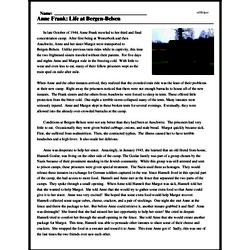Anne Frank: Life at Bergen-Belsen
In late October of 1944, Anne Frank traveled to her third and final concentration camp. After first being at Westerbork and then Auschwitz, Anne and her sister Margot were transported to Bergen-Belsen. Unlike previous train rides while in captivity, this time the two frightened sisters traveled without their parents. For five days and nights Anne and Margot rode in the freezing cold. With little to wear and even less to eat, many of their fellow prisoners wept as the train sped on mile after mile.
When Anne and the other inmates arrived, they realized that the crowded train ride was the least of their problems at their new camp. Right away the prisoners noticed that there were not enough barracks to house all of the new inmates. The Frank sisters and the others from Auschwitz were forced to sleep in tents. These offered little protection from the bitter cold. One night a terrible storm collapsed many of the tents. Many inmates were seriously injured. Anne and Margot slept in these broken tents for several evenings. Eventually, they were allowed into the already over-crowded barracks at the camp.
Conditions at Bergen-Belsen were not any better than they had been at Auschwitz. The prisoners had very little to eat. Occasionally they were given boiled cabbage, onions, and stale bread. Margot quickly became sick. First, she suffered from malnutrition. Then, she contracted typhus. The illness caused her to have terrible headaches and a high fever. It also made her delirious.




